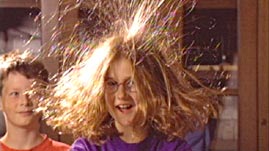Hair dryers, toaster ovens, flashlights, and television sets all work thanks to electrons. Without electrons, or more precisely the flow of electrons, millions of people would lead very different lives. This flow of electrons, also known as electrical current, is essentially the same whether it is generated by a nuclear power plant or an AA battery.
In order for electrical current to flow, three conditions must be met. One is that there must be a material, usually in the form of a wire or cable, which conducts electricity. This means that electrons can move, or flow, easily through the material, not staying locked on any particular atom by atomic forces. These materials, called conductors, have loosely held electrons, allowing for this free flow. In contrast, insulators are materials that hold onto their electrons more strongly and resist the flow of current through them.
The second requirement for electrical current to flow is the presence of a power source itself. Whatever its form, a source of electrical current creates what is called a voltage difference, which pushes electrons through the circuit. The chemical reactions inside batteries produce voltage differences between one end of the cell and the other that result in electrical current.
Lastly, electrical current requires a closed circuit. This is a length of conducting material connected at each end to a power source that also passes through the "load," the object that makes use of the current. A closed circuit allows a direct, uninterrupted flow of electrons out from the power source and back again in a complete circular connection with no beginning or end.


 Loading Standards
Loading Standards Teachers' Domain is proud to be a Pathways portal to the National Science Digital Library.
Teachers' Domain is proud to be a Pathways portal to the National Science Digital Library.
